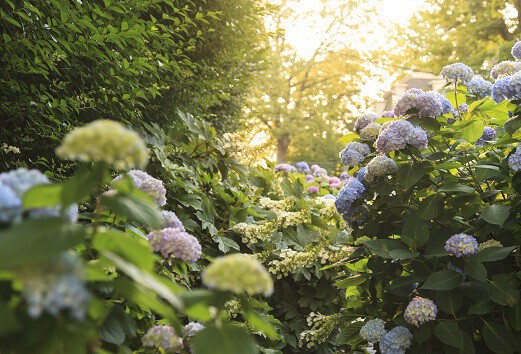Ensure your beautiful blooms look great all summer long.

For all their showy voluptuous beauty, hydrangeas are fairly simple to care for, but a few conditions will enhance their vigor and beauty. The shrubs will tolerate partial shade but prefer full sun; they will become lanky and produce fewer blossoms if they are grown in insufficient light. While these plants can thrive in nearly any well-drained soil, a soil's pH level (the measure of acidity or alkalinity) may influence the color and tone of hydrangea blossoms. Acidic soils (pH 0 to 7) tend to deepen blue shades, while alkaline environments (pH 7 to 14) brighten pinks and reds. You can check the pH of your soil with a simple test kit available from your local nursery. For a more accurate result, consult your local extension agency for information on professional soil testing. You can adjust the soil's pH at the time of planting (increase the acidity by adding peat moss and sulfur, or increase the alkalinity by adding lime), but this is unnecessary: Whatever the pH, you will not be disappointed in the colors your hydrangeas will achieve.
Three easy-to-grow hydrangeas that are also good for cutting and drying are the mophead, peegee, and oakleaf. The first (Hydrangea macrophylla) is called hortensia in Europe, where it was named after Mlle. Hortense de Nassau in 1790. An English botanist later obscured the name's origin, assuming that it came from hortensis, Latin for "of gardens." Today, few are likely to confuse the large, rounded blue, pink, or white heads for anything but the happily gaudy mophead.
Hydrangea paniculata is a huge, hardy species that may grow thirty feet tall. Its white blooms are cone-shaped and usually measure eight to ten inches long. It is the parent of the popular H. paniculata 'Grandiflora,' commonly known as peegee (a tag drawn from the initials of its species and cultivar names).
RELATED: GET TO KNOW HOW MARTHA GREW HER STUNNING CLIMBING HYDRANGEAS
The oakleaf hydrangea (H. quercifolia) was discovered in North America in the 1770s. It has white blossoms and lobed leaves that resemble those of the red oak. This shrub produces a stunning autumnal show as the flowers slowly dry and the leaves turn beautiful shades of russet, yellow, and brown.
Some species bloom only on new wood. This allows for indiscriminate pruning in late winter without sacrificing flowers the following summer. These include H. paniculata (USDA Zones 4 to 8) and varieties of H. arborescens (Zones 4 to 9), such as the popular 'Annabelle.' Other hydrangeas, including most H. macrophylla cultivars, flower on second-year growth only. Prune these in late winter or whenever you collect blossoms, by removing only spent flower stems.
·H. macrophylla 'Ayesha' has distinctive spoon-shaped petals that suggest rounded lilacs. It is one of the few scented hydrangeas.
·H. macrophylla 'Glowing Embers' was named for its mutable coloration. It has clusters of very large, flat flowers. Their dark-pink petals become mottled with green and red as it matures.
·H. macrophylla 'Nikko Blue' is a vigorous old form with lime-green foliage and deep-blue flowers in acidic soil.
·H. macrophylla 'Preziosa' has flowers that mature from cream white to a deep wine red with large, coarsely toothed, glossy, dark-green leaves.
·H. macrophylla 'Generale Vicomtesse de Vibraye' is a pure, pale blue in acidic soil. It has long, rather weak stems, and grows up to three and a half feet.
· H. paniculata 'Grandiflora' is one of the hardiest hydrangeas and may grow up to thirty feet. Its immense flower clusters literally weigh the branches down.